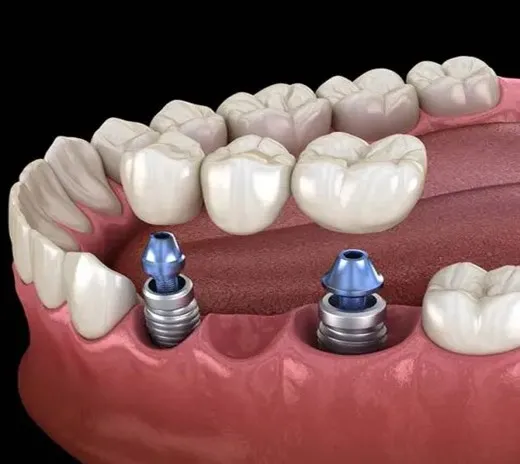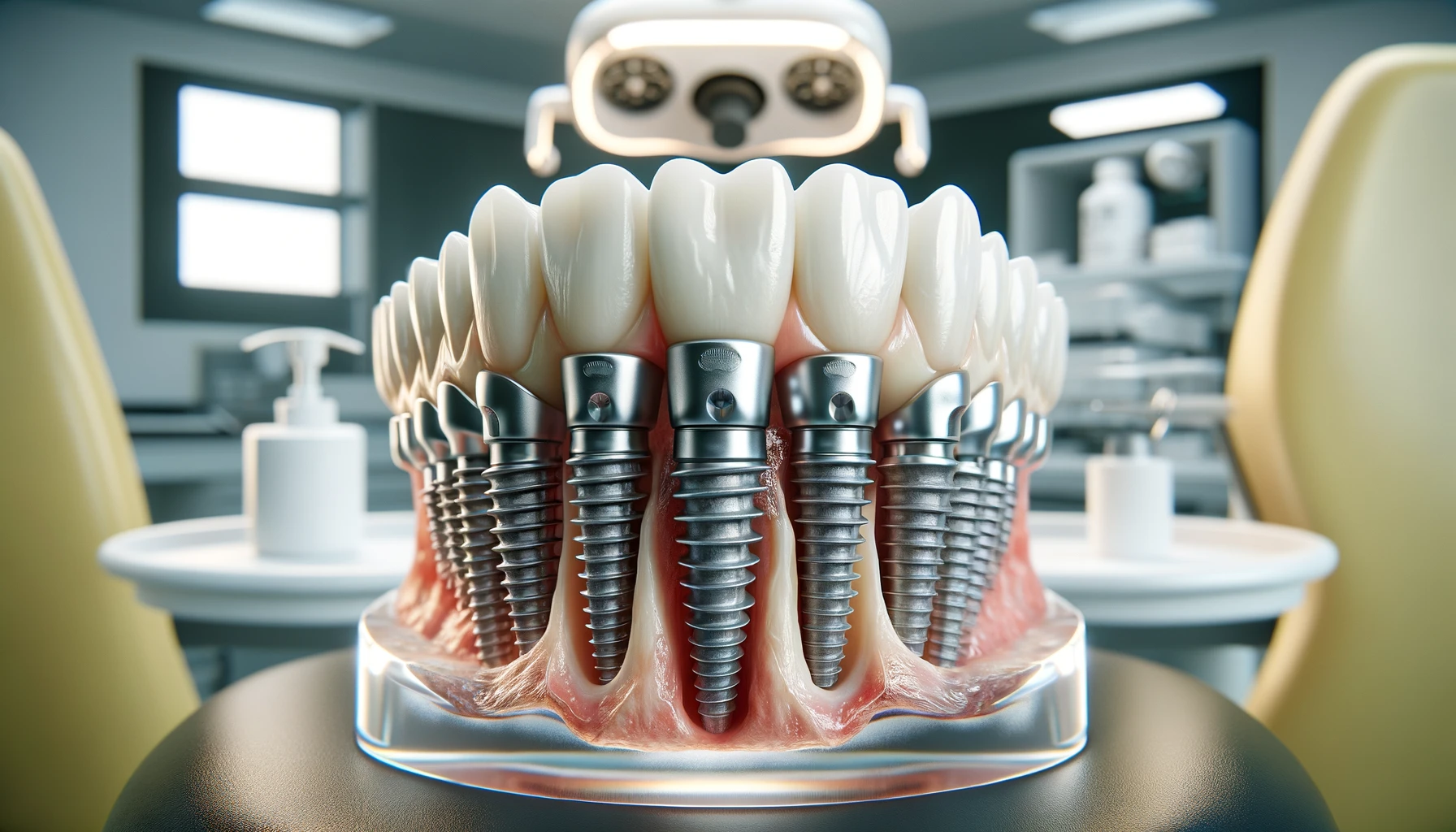Ever wonder how dental implants work? They’re not just your average tooth replacement option. The process involves a fascinating integration with your jawbone that mimics the natural function of a tooth root.
Curious about how this works and what makes it such a reliable solution for missing teeth? Let’s explore the intricate details of dental implants and how they can restore both your smile and your confidence.
Key Takeaways:
- Dental implants consist of three parts: implant, abutment, and crown for a complete tooth replacement.
- Surgical placement involves securing a titanium post in the jawbone, initiating osseointegration for stability.
- Successful osseointegration is crucial for long-term implant success and functionality.
- Maintenance includes proper oral hygiene, regular check-ups, and lifestyle adjustments for optimal implant care.

Anatomy of a Dental Implant
Understanding the anatomy of a dental implant is crucial for comprehending how this dental procedure works. A dental implant consists of three main parts: the implant, the abutment, and the crown.
The implant is a titanium post that’s surgically placed into the jawbone to serve as a replacement for the tooth root. This post provides a sturdy foundation for the rest of the implant.
The abutment is then attached to the implant and acts as a connector between the implant and the crown. It’s responsible for holding the crown securely in place.
Finally, the crown is the visible part of the dental implant that resembles a natural tooth. It’s custom-made to match the color, size, and shape of your existing teeth, ensuring a seamless and natural-looking smile.
Each component plays a vital role in the functionality and aesthetics of the dental implant, working together to restore your smile and improve your overall oral health.
The Surgical Placement Process
When undergoing the surgical placement process for a dental implant, a skilled oral surgeon will carefully insert the titanium post into your jawbone. This step is crucial as it serves as the foundation for the artificial tooth that will be attached later.
The surgeon will make an incision in your gum to expose the bone and then drill a small hole where the implant will be placed. The titanium post is then securely positioned in the jawbone, acting as a replacement for the natural tooth root.
Once the post is in place, the gum is stitched back up, and a temporary crown may be attached while the healing process begins. It’s essential to follow post-operative care instructions diligently to ensure proper healing and integration of the implant.
The surgical placement process is a significant first step towards regaining your smile and oral functionality.
Osseointegration: Bonding With the Jawbone
To ensure the success of your dental implant, the process of osseointegration involves the titanium post bonding securely with your jawbone. This crucial phase begins after the implant is surgically placed in your jawbone. Over a period of about 3 to 6 months, the bone tissue will gradually grow around the implant, fusing with the titanium surface. This integration is vital as it provides a stable foundation for the abutment and crown to be attached later.
During osseointegration, it’s essential to follow your dentist’s instructions diligently to promote healing and allow the implant to bond effectively with your jawbone. Avoiding activities that may put undue pressure on the implant site or compromise the healing process is crucial. Maintaining good oral hygiene by gently cleaning the implant site as recommended can also support successful osseointegration.
The strength of the osseointegration process is key to the long-term success of your dental implant, ensuring stability and functionality similar to a natural tooth. Be patient and follow your dentist’s guidance to support this critical bonding phase.
Attaching the Abutment and Crown
After the successful osseointegration process, the next step involves attaching the abutment and crown to your dental implant. This phase is crucial in completing the dental implant procedure and providing you with a functional and natural-looking tooth replacement.
Here are three key aspects of attaching the abutment and crown to your dental implant:
1. Abutment Placement: The abutment is a connector piece that’s attached to the implant post. It serves as the foundation for the crown and is responsible for supporting it securely.
2. Impressions and Customization: Your dentist will take impressions of your teeth to create a custom crown that matches the color, size, and shape of your natural teeth. This ensures a seamless and aesthetically pleasing result.
3. Final Crown Placement: Once the custom crown is ready, it’s placed onto the abutment and checked for fit and comfort. The crown is then securely attached to the abutment, completing your dental implant restoration.
Maintenance and Long-Term Care
Ensuring proper maintenance and long-term care of your dental implant is essential for its longevity and optimal functionality. To maintain your dental implant, brush twice daily with a soft-bristled toothbrush and non-abrasive toothpaste. Floss gently around the implant to remove any plaque or debris, preventing gum disease and inflammation. Regular dental check-ups are crucial to monitor the implant’s condition and address any issues promptly.
Long-term care involves avoiding harmful habits like smoking, which can weaken bone structure and jeopardize the implant’s stability. Limit sugary foods and acidic beverages to prevent decay and maintain oral health. In case of any discomfort, swelling, or unusual symptoms around the implant, consult your dentist immediately for evaluation and treatment.
Additionally, wearing a nightguard if you grind your teeth can protect both your natural teeth and the implant from damage. By following these maintenance and care practices diligently, you can ensure the longevity and success of your dental implant, enjoying a confident smile and healthy oral function for years to come.
FAQs
Are Dental Implants Covered by Insurance?
Yes, dental implants are often covered by insurance, but the extent of coverage can vary. You should check with your insurance provider to understand your specific coverage and any potential out-of-pocket expenses
How Long Does the Entire Dental Implant Process Typically Take?
The entire dental implant process typically takes several months. Initial consultation, implant placement, healing period, and attaching the final restoration are steps involved. Patience is key as each phase ensures a successful outcome.
Can Dental Implants Be Used to Replace Multiple Missing Teeth?
Yes, dental implants can be used to replace multiple missing teeth. They offer a durable solution for restoring your smile and chewing function. Your dentist will evaluate your specific case to determine the best treatment plan for you.
What Are the Potential Risks and Complications Associated With Dental Implant Surgery?
When considering dental implant surgery, potential risks and complications include infection, nerve damage, implant failure, and sinus issues. Your dentist will discuss these with you before the procedure to ensure you are well-informed.
Can Dental Implants Be Used for Patients With Certain Medical Conditions, Such as Diabetes or Osteoporosis?
Yes, dental implants can be used for patients with certain medical conditions like diabetes or osteoporosis. Your dentist will evaluate your specific situation to determine if you are a good candidate for the procedure.

Jasper Bruxner is a passionate and versatile blogger with a keen eye for trends and a knack for crafting engaging content. As the founder of WendyWaldman.com, he has established himself as a trusted resource in a diverse range of niches, including food, tech, health, travel, business, lifestyle, and news. He tends to share the latest tech news, trends, and updates with the community built around Wendywaldman. His expertise and engaging writing style have attracted a loyal following, making him a respected voice in the online community.




